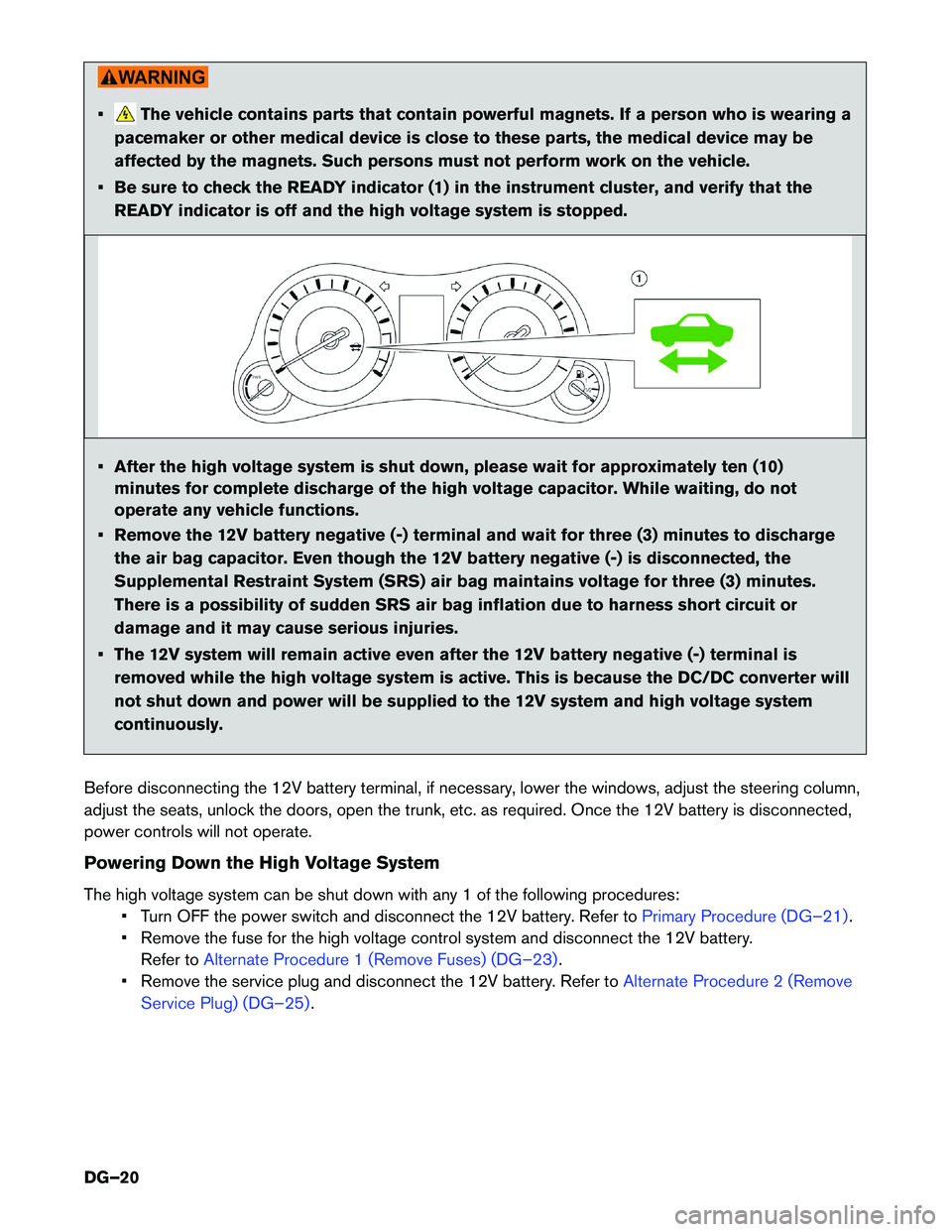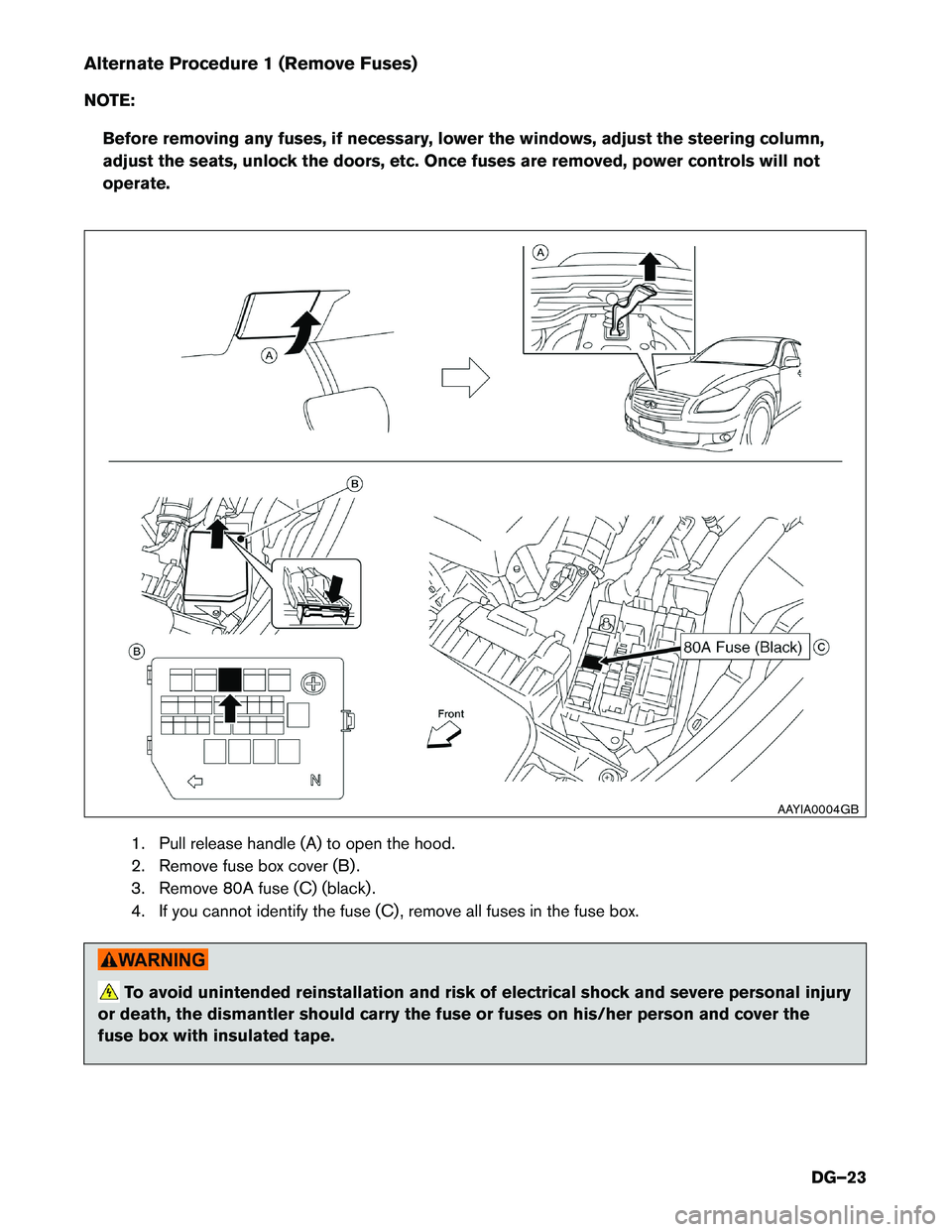fuses INFINITI Q70 HYBRID 2014 Dismantling Guide
[x] Cancel search | Manufacturer: INFINITI, Model Year: 2014, Model line: Q70 HYBRID, Model: INFINITI Q70 HYBRID 2014Pages: 51, PDF Size: 3.65 MB
Page 20 of 51

• The vehicle contains parts that contain powerful magnets. If a person who is wearing a
pacemaker or other medical device is close to these parts, the medical device may be
affected by the magnets. Such persons must not perform work on the vehicle.
• Be sure to check the READY indicator (1) in the instrument cluster, and verify that the READY indicator is off and the high voltage system is stopped.
• After the high voltage system is shut down, please wait for approximately ten (10) minutes for complete discharge of the high voltage capacitor. While waiting, do not
operate any vehicle functions.
• Remove the 12V battery negative (-) terminal and wait for three (3) minutes to discharge the air bag capacitor. Even though the 12V battery negative (-) is disconnected, the
Supplemental Restraint System (SRS) air bag maintains voltage for three (3) minutes.
There is a possibility of sudden SRS air bag inflation due to harness short circuit or
damage and it may cause serious injuries.
• The 12V system will remain active even after the 12V battery negative (-) terminal is removed while the high voltage system is active. This is because the DC/DC converter will
not shut down and power will be supplied to the 12V system and high voltage system
continuously.
Before disconnecting the 12V battery terminal, if necessary, lower the windows, adjust the steering column,
adjust the seats, unlock the doors, open the trunk, etc. as required. Once the 12V battery is disconnected,
power controls will not operate.
Powering Down the High Voltage System
The high voltage system can be shut down with any 1 of the following procedures: • Turn OFF the power switch and disconnect the 12V battery. Refer to Primary Procedure (DG–21)
.
•
Remove the fuse for the high voltage control system and disconnect the 12V battery.
Refer to Alternate Procedure 1 (Remove Fuses) (DG–23) .
•
Remove the service plug and disconnect the 12V battery. Refer to Alternate Procedure 2 (Remove
Service
Plug) (DG–25) .DG–20
Page 23 of 51

Alternate Procedure 1 (Remove Fuses)
NO
TE:
Before removing any fuses, if necessary, lower the windows, adjust the steering column,
adjust the seats, unlock the doors, etc. Once fuses are removed, power controls will not
operate.
1. Pull release handle (A) to open the hood.
2. Remove fuse box cover (B) .
3. Remove 80A fuse (C) (black) .
4. If you cannot identify the fuse (C) , remove all fuses in the fuse box. To avoid unintended reinstallation and risk of electrical shock and severe personal injury
or
death, the dismantler should carry the fuse or fuses on his/her person and cover the
fuse box with insulated tape. AAYIA0004GB
DG–23
Page 28 of 51

11. Wait approximately ten (10) minutes for complete discharge of the high voltage capacitor after
the service plug has been removed.
12. Perform the dismantling operation. Refer to 6. Dismantling Information (DG–38).
3-4.2
Cutting the Vehicle Body • Do not cut into high voltage related areas to avoid severe personal injury or death.
• Do not cut into the Li-ion battery to avoid severe personal injury or death.
• When removing parts, NEVER touch the high voltage parts or the insides of the
exposed
orange-colored high voltage cables to avoid severe personal injury or death.
Personal Protective Equipment (PPE) must always be worn when touching or
working on high voltage components. To avoid unintended reinstallation and risk of electrical shock and severe personal injury or
death,
the dismantler should carry the fuses or service plug on his/her person while work
is in progress. Do not cut air bag parts to avoid unintended deployment of the air bags and the risk of
severe
personal injury or death.
If approximately ten (10) minutes have passed since the rescuer shut down the high voltage system (refer to
3-4.1 High Voltage System Shut-Down Procedure (DG–19)) , then the dismantler can cut the vehicle
except
for the Li-ion battery. DO NOT cut the Li-ion battery due to possible electrocution risk and electrolyte solution
leakage.
DG–28